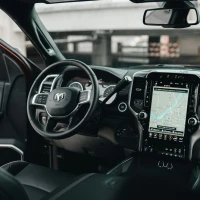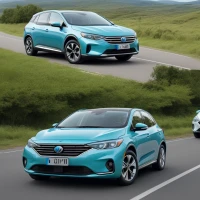The very essence of transportation is undergoing a revolution, poised to transform our roads and redefine our travel experiences. The driving force behind this profound change is autonomous driving technology. In recent years, we have witnessed groundbreaking advancements that are not just intriguing prospects for the future, but present-day realities steering us towards a new era in transportation.
Autonomous driving has come a long way from mere conceptualization to actual on-road applications, and the progression is far from over. This detailed exploration delves into the innovative technologies and groundbreaking trends propelling autonomous driving forward, revealing how these vehicular marvels could shape the future of our transport infrastructure.
Emerging Leadership in Autonomous Technology
As we cruise into a more automated future, certain trailblazers in the vehicle industry are accelerating the shift towards full autonomy. A testimony to human ingenuity, these innovators are achieving what once seemed like science fiction. In this section, we’ll examine the cutting-edge breakthroughs and the entities championing these changes.
The Vanguard of Autonomous Development
- Tesla’s Autopilot and Full Self-Driving (FSD): Tesla has arguably become synonymous with the term autonomous driving. With features like Navigate on Autopilot, Auto Lane Change, Autopark, Summon, and Traffic Light and Stop Sign Control, Tesla continues to push the envelope in self-driving technology.
- Waymo’s Driverless Fleet: A subsidiary of Alphabet Inc., Waymo is making headway with its autonomous driving technology. It operates a fully driverless taxi service in Phoenix, Arizona, and is considered a leader in the autonomous driving space.
- Cruise Automation’s High-definition Maps: Cruise, backed by General Motors, shines with its cutting-edge high-definition maps and sensor technology. By crafting incredibly detailed maps of urban environments, Cruise vehicles can navigate bustling city streets with precision.
The Path to Full Autonomy
Achieving full autonomy, commonly referred to as Level 5, requires overcoming substantial technical hurdles. The vehicle must master navigation without any human oversight in all possible driving scenarios. Key components in this pursuit include:
- Advanced Sensors and Radar: Robust sensory equipment that can reliably detect obstacles, interpret traffic signals, and understand road conditions, even in adverse weather.
- Machine Learning Algorithms: Self-improving algorithms that adapt based on accumulated driving data, refining the vehicle’s decision-making capabilities.
- V2X Communication: Vehicle-to-everything (V2X) technology allows for seamless communication between the autonomous vehicle, other cars on the road, traffic infrastructure, and even pedestrians.
The Backbone of Autonomy: Breakthrough Sensor & AI Technology
Behind every autonomous vehicle is a suite of sophisticated sensors and AI systems that serve as its eyes and brain. This technological backbone plays a pivotal role in the safe and accurate navigation of self-driving cars.
Sensor Suite Evolution
LiDAR Technology
LiDAR (Light Detection and Ranging) sensors cast an array of laser beams to create a high-resolution, 3D representation of the vehicle’s surroundings. Innovations in LiDAR are making it smaller, more cost-effective, and more powerful, enhancing its appeal for mass-market adoption.
Camera and Vision Systems
High-resolution cameras provide a panoramic view around the vehicle. Advancements in computer vision and neural networks enable these systems to interpret visual data with remarkable precision, closely mimicking human sight.
Radar Advancements
Radar sensors are not new, but their advancement is crucial for autonomous vehicles. Modern radars offer superior range and can detect objects with high accuracy, essential for autonomous driving in diverse conditions.
The AI Revolution in Autonomous Driving
Artificial intelligence is the linchpin that processes the deluge of sensor data. AI algorithms are continually refined, becoming more adept at anticipating and reacting to an infinite variety of road situations. Key innovations include:
- Deep Learning Models: These neural network architectures learn complex patterns in data, essentially enabling vehicles to “think” and make decisions akin to a human driver.
- Simulation and Synthetic Data: AI models harness synthetic data generated from simulations to learn from countless scenarios, including rare or dangerous ones that are hard to source from real-world driving.
Road to Regulation: Legal Frameworks and Standards
With technology racing ahead, regulations must keep pace to ensure that autonomous vehicles coalesce seamlessly and safely into our transport systems. The outline of a legal and regulatory framework is becoming ever clearer as policymakers, and industry leaders collaborate.
Establishing Safety Protocols
Testing and Certification Standards
Standards for testing and certification of autonomous vehicles are being developed to ascertain their safety before they hit public roads. Metrics for validating sensor accuracy, software reliability, and cyber-security features are all under rigorous scrutiny.
Ethical Considerations
Discussions around the ethical decision-making of AI in critical scenarios, such as the moral trade-offs in unavoidable accidents, remain ongoing. Transparent and ethical AI principles are being entrenched at the core of autonomous vehicle development.
Integrating Autonomous Vehicles into Society
The roll-out of autonomous driving will not simply be about putting self-driving cars on the road. It’s about smoothly integrating them into a multifaceted transport ecosystem, poised to benefit commuters, businesses, and urban planners alike.
Impacts on Urban Planning and Infrastructure
Smart Cities and IoT
The advent of autonomous vehicles heralds a larger movement towards smart cities. Internet of Things (IoT) devices will interact with autonomous vehicles to manage traffic flow, reduce congestion, and minimize emissions.
Road Infrastructure Changes
Roads may need redesigning to accommodate autonomous vehicles better. Dedicated lanes, modified traffic signals, and updated road signage are some of the potential infrastructural amendments.
A Glimpse into the Autonomous Future
The trajectory of autonomous driving is set to revolutionize the transport sector. In the not-so-distant future, we may find ourselves in a world where traffic jams, road accidents, and the stress of daily commutes are distant memories.
Autonomous Driving: Beyond Passenger Cars
Commercial and Industrial Applications
Beyond personal transportation, autonomous technology is finding robust applications in commercial trucking and industrial logistics, ushering in unprecedented efficiency and safety levels.
Public Transport and Mobility Services
Self-driving buses and shuttles are becoming a reality, potentially transforming public transport into a more flexible, on-demand service.
Final Thoughts on Stepping into an Autonomous World
The innovations in autonomous driving present a compelling vision of the future – one that is safer, cleaner, and more efficient. As we steer towards this horizon, it’s clear that these vehicular wonders will be much more than modes of transport; they will be the driving force behind a comprehensive societal shift. The road ahead is long and winding, but with every advancement in autonomous technology, the contours of a new reality become sharper, beckoning us towards a destination that was once the stuff of dreams.
Embracing these innovations requires not just technical ingenuity but also societal readiness to adapt to disruptive change. Whether it’s overhauling regulations, retrofitting infrastructure, or reimagining cityscapes, the journey to full autonomous driving promises to be as transformative as the destination. As we collectively navigate this uncharted terrain, one thing is certain: the wheels are already in motion, and there’s no turning back.










